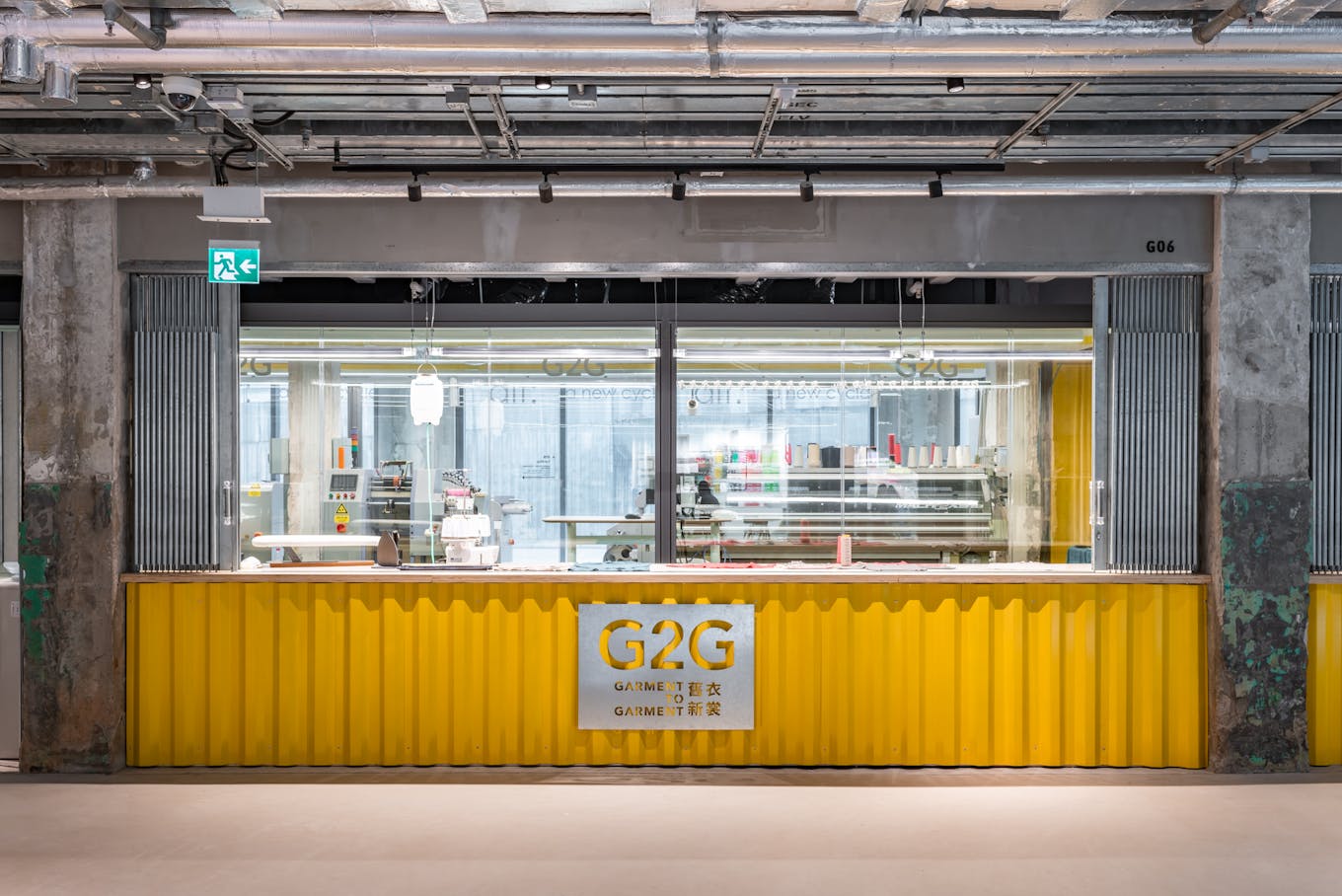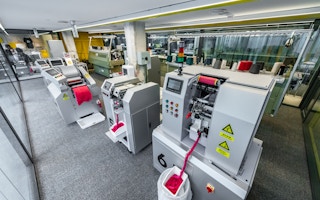What does one do with an unwanted t-shirt or sweater?
Since last year, Hong Kong residents have been able to take the items to a former textile mill building in Tsuen Wan, and watch as machines work their magic to turn them into brand new sweaters.
The Garment-to-Garment (G2G) Recycle system cleans and shreds the old garment before reconstituting the straightened fibres into yarn.
Consumers get to see their unwanted clothes recycled in real time in a 40-foot container that houses the system.
G2G, set up by The Hong Kong Research Institute of Textiles and Apparel (HKRITA) with funding from the H&M Foundation, Novetex Textiles Limited and the territory’s Innovation and Technology Commission, is upending the linear fashion supply chain, one garment at a time.

The Garment-to-Garment system is located in a retail shop at The Mills, a revitalised art and cultural complex in Tsuen Wan, Hong Kong. Image: HKRITA
“
We have developed a global supply chain over the years where we make things in the East, and consume things in the West. So, the materials for recycling exist in the wrong marketplace.
Edwin Keh, chief executive, The Hong Kong Research Institute of Textiles and Apparel (HKRITA)
The system currently processes 40 garments in a month, but HKRITA chief executive Edwin Keh is hopeful that a commercial system can be up and running in about a year.
HKRITA also aims to expand the range of materials that G2G can process; currently, materials such as denim, Lycra, spandex and leather are out.
Is the mini production line a harbinger of how the logistics of reducing fashion waste could take shape? What other elements are needed to build a reverse supply chain for fashion?
Righting the wrong marketplace
“We have developed a global supply chain over the years where we make things in the East, and consume things in the West. So, the materials for recycling exist in the wrong marketplace,” Keh told Eco-Business. The majority of garments supplied to the world are made in places like China, Vietnam and Bangladesh.
While the fashion industry has put in place a highly effective global supply chain that is able to design, source, make and ship garments to end-consumers in a matter of weeks, it has yet to engineer a reverse supply chain of the same scale to deal with the growing heaps of unwanted clothes.
Driven by the fast fashion phenomenon, clothing production roughly doubled between 2000 and 2014. More than half the clothes produced are said to be dumped within a year, and the industry generates about 10 per cent of global greenhouse gas emissions.
The G2G system offers ideas on solving the reverse logistics challenge. “We set it up as a way of processing post-consumer materials in the marketplace of consumption,” said Keh.
“Assuming the structure of the global supply chain isn’t going to change much—in that retailers and brands will continue to manufacture the lion’s share of products in developing countries to sell in the developed world—what we need are in-country solutions which can process and treat the materials,” he said.
G2G has drawn interest from shopping mall operators and fashion brands, and Keh said it ultimately has to make business sense. Its products have to cost less than if virgin materials were used, and they have to be of comparable quality and performance. According to the Ellen MacArthur Foundation, less than 1 per cent of old clothing is currently made into new clothing, while about 12 per cent is recycled in some way, such as for insulation or mattress stuffing.
Creating demand and a compliant supply chain
Companies that want to grow the market for recycled and upcycled fashion must also raise awareness among customers, and get their supply chains up to speed.
Some, such as knitwear supplier Cobalt Fashion, have joined sustainability non-profit Forum for the Future’s Circular Leap Asia programme, a two-year innovation programme that aims to help apparel manufacturers, brands and retailers in Asia develop and scale circular solutions.
A member of supply chain and logistics conglomerate Fung Group, Cobalt designs, sources and works with factories to supply knitwear to clients such as specialty stores, high-end labels and mass market retailers.
Its chief operating officer Roger Chan sees circular fashion as an opportunity to rethink the supply chain.
The company has been blending recycled textiles into its garments for some time. In 2019, it shipped over 1.6 million garments designed and produced from recycled fibres. This year, it expects shipments of garments using recycled content to grow in volume by 60 per cent.

Cobalt’s chief operating officer Roger Chan. Image: Cobalt
“The desire for circular and sustainable fashion is growing rapidly. From all perspectives—our push to conserve resources, drive environmental efficiency, and meet growing consumer demand—it makes business sense, in addition to being right from an ethical and environmental perspective,” said Chan.
To promote the concept to consumers, Cobalt established an upcycled fashion brand called 22 Factor, which uses upcycled virgin yarn that would otherwise be discarded to create premium knitwear at a fraction of the price.
Cobalt will soon offer a circular textiles option where used garments are collected from stores for reuse, or recycling into new fibres, said Chan. It will involve supply chain partners across several countries working together under Cobalt’s direction.
“
As an industry, we are used to ensuring compliance in the production chain, and this needs to be replicated in the recycling and reuse chain as well.
Roger Chan, chief operating officer, Cobalt Fashion
Even with guidance and greater knowledge, there are challenges every step of the way, Chan noted.
“All parts of the supply chain, wherever they are located, need to develop new sets of capabilities in terms of design, compliance, tracking and efficiency,” he said.
Cobalt has to train its designers on sustainable fashion as well as new technologies such as 3D virtual design and sampling. It also faces compliance challenges: Recycling facilities need to uphold the same safety, labour and environmental standards seen in the rest of the supply chain, and these credentials need to be verified.
“As an industry, we are used to ensuring compliance in the production chain, and this needs to be replicated in the recycling and reuse chain as well. We are confident it can be done, but it will take time and collaboration,” said Chan.
For a reverse supply chain to take off, collectors of unwanted or discarded clothes have to see themselves not as waste companies, but as suppliers of quality feedstock for recycled fabric, said Kia Jiehui, principal strategist and Asia Pacific circular economy lead at Forum for the Future.
“
There is no lack of existing recycling technologies, but they require raw materials to be fairly standardised and typically require a minimal volume in order to be cost-effective.
Kia Jiehui, principal strategist and Asia Pacific circular economy lead, Forum for the Future
“We need collection and recycling companies that see ‘waste’ not as waste, but as raw material input to the manufacturing process,” said Kia.
“There is no lack of existing recycling technologies, but they require raw materials to be fairly standardised and typically require a minimal volume in order to be cost-effective. The challenge lies in consolidating waste textiles from multiple sources to achieve scale, then sorting them effectively by fibre types,” she said. “From the manufacturers’ point of view, if the supply of feedstock is not consistent, there cannot be a consistent recycled product.”
Today, there are many manufacturers that supply recycled yarn, but their ability to fully trace the source of the recycled material and provide customers with that information is limited, she noted. Greater traceability will only be possible if retailers, collectors and manufacturers work together. Cobalt has the opportunity to align incentives and information sharing across this reverse supply chain.
Regulation, and pricing garments right
Experts say design and legislation also play key roles.
Garments can be designed for durability and use safe and renewable inputs that can be taken apart and put back into any recycling process, said Laura Balmond, a project manager at Make Fashion Circular, an initiative of the Ellen MacArthur Foundation.
Materials should be reusable and clearly labelled on garments, and blended materials should be easy to separate, said Keh.
Apparel today is mispriced, and legislation can help to ensure that the cost of treating post-consumer textiles is taken into account, he added.
“We’ve figured out the cost to the consumer but we’ve not figured out the end-of-life and recycling cost. Regulation around disposal and reuse is necessary if we want to solve this, because, today, there is no incentive other than consumer pressure, but that’s just not enough.”












